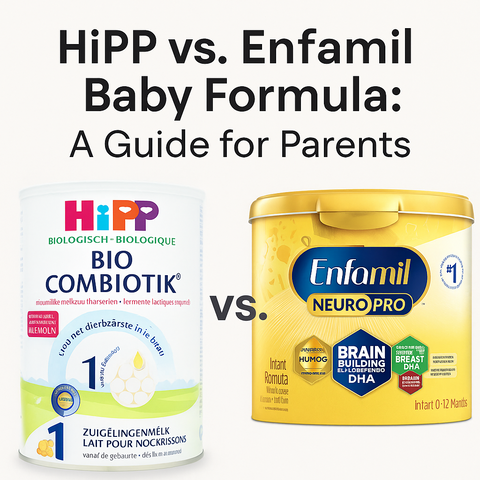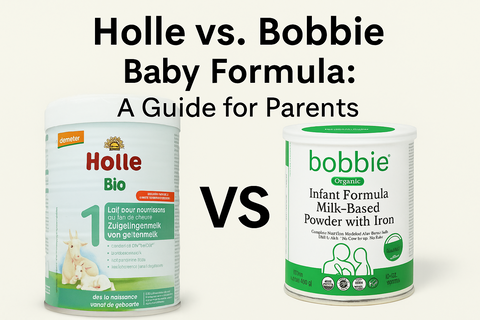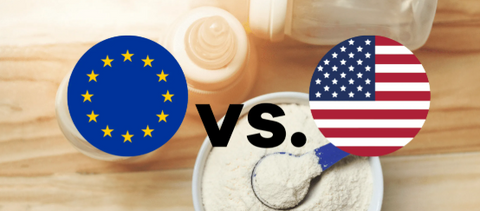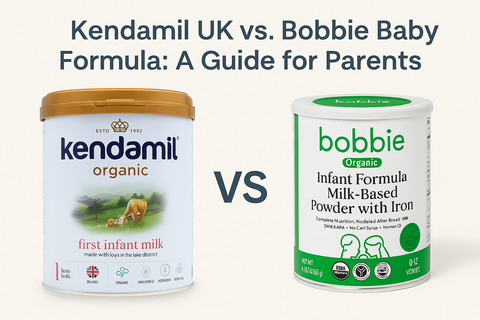Comfort Nursing: A Beautiful Bonding Experience
In the world of parenting, where every day is an adventure, there exists a nurturing practice known as Comfort Nursing. Comfort Nursing is also known as non-nutritive sucking, non-nutritive breastfeeding, flutter sucking, or comfort feeding. This is when your little one snuggles up to your breast for love, reassurance, and closeness rather than just for food. Comfort nursing is a bonding tool for mothers and their little ones. It’s also natural and instinctual behavior for newborns, playing a vital role in their development and overall well-being. Whether you're a first-time mom or a seasoned pro, we want to assist you with this blog with all the knowledge and confidence to embrace this nurturing practice ;).
Benefits of Comfort Nursing
The bond between a mother and her newborn is unique, and comfort nursing is just one of the beautiful ways to strengthen this incredible bond. Let's explore 6 (psychological) benefits and understand how non-nutritive sucking can help your little one sleep better while promoting security and connection.
1. Soothing Breastfeeding
One of the main benefits of comfort nursing is the soothing effect on your little one. It can help calm a fussy or distressed baby by providing instant comfort when upset or irritable. The gentle rhythm of sucking helps release calming hormones, promoting a sense of well-being.
2. Comfort Nursing at Night
During nighttime awakenings, comfort nursing can be a godsend. It allows your baby to quickly fall back asleep, minimizing disturbances to your own sleep routine. This nurturing experience helps you and your little one enjoy more restful nights.
3. Comfort Nursing vs. Hunger
Distinguishing between comfort nursing and hunger can be challenging, especially for new parents. However, some signs can help you differentiate the two:
- Sucking Pattern: Comfort nursing involves shallow, rhythmic sucking with occasional pauses. Hunger-related nursing usually has a more intense and continuous sucking pattern.
- Nutrient Intake: If your baby has recently fed and is exhibiting hunger cues shortly after, it might be comfort nursing. Babies typically consume a substantial amount of milk during a feeding, leaving them content for a reasonable duration.
- Body Language: Observe your little ones body language. If they're content, have a relaxed body posture, and are not displaying signs of hunger, like putting their fists in their mouth, it's more likely comfort nursing.
4. Comfort Nursing Sleep
Comfort nursing often accompanies your baby into dreamland. Nursing promotes drowsiness, helping your little one ease into sleep. While it may mean waking up for night feeds, many parents find comfort nursing more manageable than trying to soothe a crying baby.
5. Comfort Nursing During Growth Spurts
Babies go through growth spurts, requiring more comfort and nutrition. Comfort nursing can help meet their increased need for closeness and reassurance. Your body responds by producing more milk to support its growing demands.
6. Comfort Nursing and Bonding
Feeding time is more than just getting your little one's tummy full as it's an opportunity to bond and connect. Comfort nursing enhances this bond by creating a strong trust between you and your newborn. Your baby learns that you're there to meet not only their physical needs but also their emotional needs.

Comfort Nursing Tips
Navigating comfort nursing can be a satisfying experience with these simple tips:
- Responsive Nursing: Respond promptly when your baby seeks comfort at the breast. Offering the breast when your baby desires it helps them feel secure.
- Comfort Nursing Positions: Find comfortable nursing positions that work for you and your baby. This might include the cradle hold, football hold, or side-lying position.
- Create a Relaxing Environment: Choose a quiet, comfortable space for feeding sessions. Dim the lights, play soft music, or use white noise to create a calming atmosphere.
- Pacifying Techniques: If your little one continues seeking comfort after nursing, you can try soothing techniques such as gentle rocking or swaddling.
- Support: Connect with other breastfeeding parents or (online) support groups to share experiences and seek advice.
Extended Comfort Nursing
Comfort nursing isn't limited to the newborn stage. Many older infants and toddlers continue to find comfort in nursing, even if they also consume solid foods. Extended comfort nursing can provide emotional support during developmental milestones and times of stress.
Moving Away from Comfort Nursing
Gradual weaning from comfort nursing is a loving way to guide your baby toward greater independence while acknowledging the beautiful connection you've built through breastfeeding. It's a journey that honors your baby's emotional needs and allows both of you to continue to grow together. Here are some 3 tips to help you through this transition:
- Introduction of Alternatives: Introduce alternative soothing methods to your baby. This could include offering a pacifier, gently massaging their back or tummy, rocking them, or singing them a lullaby. These alternatives can help your baby learn different ways to find comfort beyond nursing.
- Slow Reduction: Begin the process of gradual weaning by slowly reducing the frequency and duration of comfort nursing sessions. Replace these nursing sessions with the soothing techniques mentioned earlier. This slow reduction allows your baby to adjust to the changes without feeling overwhelmed.
- Embracing Independence: Remember that weaning from comfort nursing doesn't mean giving up the emotional connection with your baby. Instead, it's about helping your baby gradually become more independent in finding comfort. This process respects your baby's growing need for self-soothing while maintaining the strong bond you share.
In Summary
Comfort Nursing is a profound practice that strengthens the bond between mother and child. It offers numerous psychological benefits, soothing both baby and mother, especially during nighttime awakenings. Distinguishing it from hunger can be challenging, but understanding the subtle cues helps. This nurturing experience eases babies into sleep and supports their growth. Beyond nourishment, it fosters emotional connection and trust.
Navigating comfort nursing is easier with responsive nursing, comfortable positions, a tranquil environment, and soothing techniques. It extends beyond infancy, offering emotional support during developmental milestones. Gradual weaning, when the time comes, honors the bond you've built, allowing your child to gradually embrace independence while maintaining your strong connection.
Any Questions?
Our customer success team has earned hundreds of 5-star reviews from customers dedicated to helping you provide the best nutrition for your little one. Contact us here or shoot us an email at support@organicformulashop.com. Happy Feeding!
10 FAQs about Comfort nursing.
- What is comfort nursing?
- Comfort nursing, aka non-nutritive sucking or flutter sucking, is when a baby breastfeeds primarily for comfort, reassurance, and emotional closeness rather than solely for nourishment.
- Is comfort nursing the same as cluster feeding?
- No, comfort nursing and cluster feeding are different. Comfort nursing is about seeking emotional comfort, while cluster feeding involves frequent, closely spaced feeding sessions within a short period, often during specific times of the day.
- When do babies engage in comfort nursing?
- Babies can engage in comfort nursing at any time of the day or night, driven by their need for comfort and security rather than hunger.
- What are the benefits of comfort nursing for my baby?
- Comfort nursing promotes serenity, nurtures the mother-baby bond, offers reassurance and security, and can help babies fall asleep. It also provides emotional support during growth spurts and developmental changes.
- Can comfort nursing interfere with sleep training?
- While comfort nursing doesn't prevent sleep training, some parents establish sleep routines and self-soothing methods at an appropriate time for their baby's development.
- How can I differentiate between comfort nursing and hunger cues in my baby?
- Understanding your baby's cues is essential. Hunger cues may include vigorous sucking, turning toward the breast, or continuous crying. Comfort nursing cues often involve gentle flutter sucking, seeking closeness, and calmness.
- Does comfort nursing indicate insufficient milk supply?
- No, comfort nursing is not a sign of inadequate milk supply. It's a separate practice for emotional comfort and bonding.
- Is it possible for babies to become overly dependent due to comfort nursing?
- Comfort nursing fosters secure attachments and emotional development. It doesn't lead to spoiled or overly dependent babies; it helps them feel secure and loved.
- How can I gradually wean my baby from comfort nursing?
- Gradual weaning from comfort nursing can involve introducing alternative soothing methods, slowly reducing nursing sessions, and seeking support from lactation consultants or breastfeeding groups.
- Is there a difference between comfort nursing and using a pacifier?
- While both provide comfort, comfort nursing involves direct contact with the mother's breast, offering additional benefits like skin-to-skin bonding and potential pain relief for babies.
Important note:
Always consult your pediatrician before making decisions about your newborn’s diet or if you notice any changes in your baby’s health. Please be aware that this information is based on general trends in babies and mothers and is not medical advice. Breastfeeding is the best nutrition for your baby because breast milk provides your child with all the essential nutrients they need for growth and development.




